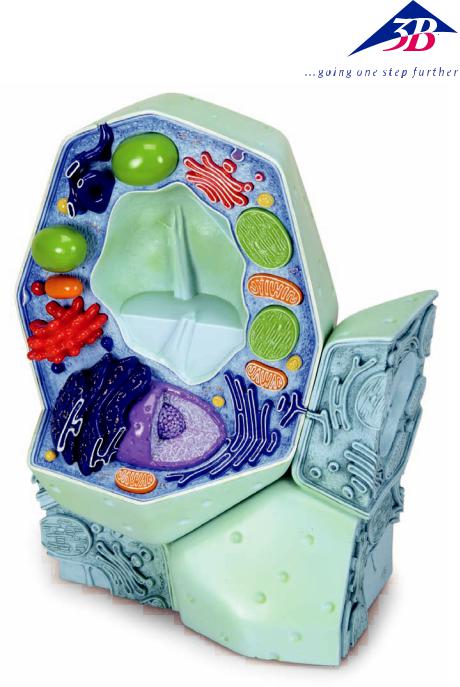3B Scientific Plant cell User Manual [en, de, es, fr, it]

R05

Model of a Plant Cell
English
(Magnification approx. 500,000-1,000,000)
The history of cytology
Cytology is an independent science in botany and deals with the structure and function of plant cells. The term cell (Latin: cellula = chamber, compartment, cell) was coined in 1665 by Robert Hooke, after he had discovered and recorded the cells within the tissue of a bottle cork with the help of one of the earliest light microscopes. At the beginning of the 19th Century, Franz Meyen (1804-1840) recognised cells as the elementary units of plant organs. In 1838/1839, Matthias Jacob Schleiden and Theodor Schwann establish cell theory: “Cells are the basis for all plants and animals.” In 1845, Karl Theodor Ernst von Siebold, based on his observations on protozoa (unicellular organisms), wrote that cells can exist independently and represent the smallest unit of life. At the same time, Louis Pasteur and other scientists refuted the prevailing theory of the time which stated that cells can originate spontaneously out of dead organic matter (generatio spontanea). In 1855, Rudolf Virchow confirmed Meyen’s theory which stated that every cell originates from another cell (“omnis cellula ex cellula”). In 1879, Eduard Strasburger discovered the division of the nucleus in plants. An important breakthrough in understanding the structure and function of cells was achieved by E. Ruska and H. Mahl in 1940, thanks to the development of the transmission electron microscope.
As in the animal world, plant cells, too, are characterised by the following:
•They have a more complex structure than their environment
•They react to inner and outer stimuli
•They have the ability to reproduce
Differences between animal and plant cells
In spite of the consistency regarding the cellular structure of animal and plant cells – which had been detected by Schleiden and Schwann in 1838 – there still are important differences® in their basic structural plan. The following three features characterise the differences between most plant cells and animal cells:
1.Plant cells are enclosed by a cell wall which is responsible for resisting the inner osmotic pressure of the cell (turgor pressure), thereby giving it rigidity and increased stability.
2.As organelles, only plant cells possess plastids. These include, for example, the green chloroplasts, the scene of photosynthesis.
3.They possess the sap vacuoles characteristic of plants, in which dissolved substances are stored and macromolecules broken down.
Plant cells have an average size of 10-100 µm and can be observed by using a simple light microscope. A tree is made up of 1013 (= 10 trillion) cells! In multicellular organisms, they form groups of homogenous, in part strongly differentiated and specialised cells (= tissues).
Structure and function of a plant cell
(For numbering see diagram)
Note: Unlike the model presented, all components of a living cell are in a state of constant motion!!!
The individual cell components have differences in their composition, e.g. proteins/enzymes, ionic milieu, etc., and can best be classified according to their functions. An important term in plant cytology is protoplast, which refers to a cell surrounded by a plasma membrane in which the cell wall has been removed.
Cytoplasm with cytoskeleton (1)
In the course of evolution, a kind of division of work originated in a cell. This division of work is called compartmentation. It is achieved when special reaction complexes, the organelles (Greek: organon = tool), are surrounded and defined by membranes. These organelles can be detected, with the help of a light microscope, in the fluid and colourless cytoplasm of protoplasts (60 to 90% water, proteins, lipids, nucleic acids). The cell membrane (2) forms the boundary of the cell, marking it off from its exterior surroundings. The cell membrane consists of monomolecular layers of phospholipids and proteins which can move in the lipid matrix (“fluid mosaic” – model). Incidentally, all plant and animal membranes are based on the same elementary principle (unit membrane).

English
Model of a Plant Cell
(Magnification approx. 500,000-1,000,000)
This membrane is responsible for controlling the selective transport into and out of the cell. It has the same function with regard to the organelles, too. The cytoskeleton in the cytoplasm, which is made up of proteins, guarantees not just the stability of the cell but also the most diverse intracellular movements (e.g. visible plasma streams).
Nucleus (3a) with nucleolus (3b)
The nucleus (approx. 5-25 µm) is the information centre of the cell. It is enclosed within a double membrane lining with defined channels (= nuclear pores for controlling the metabolic flow between the nucleus and the cytoplasm) and contains the main part of the cell’s genetic information, present in the form of chromatin. Only during cell division is the chromatin (normally not visible under a light microscope) transformed into its more compact form, viz. chromosomes. In the process, the DNA, which is bound by proteins, is strongly reduced by condensation and spiralisation. The nucleoli occur exclusively in the interior of the nucleus and are the site for the synthesis of preliminary stages of cytoplasmic ribosomes (5).
Endoplasmic Reticulum (smooth ER (4a) and rough ER (4b)) Ribosomes (5)
All proteins of the cell are built at the “sewing machine” of proteins, the ribosomes. These extremely small organelles (approx. 20-30 nm) can float freely in the cytoplasm or get attached to the sacciform or tubular membrane system of the endoplasmic reticulum (rough ER). Inside the ER´s compartment, proteins are in part transformed into helper proteins, commonly known as molecular chaperones, and are transported to their biophase. The smooth ER, without ribosomes attached, is mainly responsible for the synthesis of lipids. The structure of the ER is extremely dynamic and always subject to constant reorganisation. The ER is also connected to the membrane coating of the nucleus. That is to say, the membrane® and the lumens of both of the organelles blend directly with one another.
Plasmodesmata (6)
Plasmodesmata constitute contact structures between neighbouring plant cells. In the process they form connections, in the form of fine channels, between the living protoplasts through the cell wall and the middle lamella. The coupling is built through tubular ER cisternae of both of the cells and its function is to transfer low-molecular substances between cells.
Plastids
Plastids are compartments typical to plant cells. They are always surrounded by a double membrane. The inner membrane is formed for the purpose of enlarging the reactive surface into the interior of the plastids. Plastids emerge on their own from the division of young proplastids and spread themselves during mitosis into daughter cells. Chloroplasts possess their own genetic information (ring-shaped, extrachromosomal genome; plastids DNA).
The green chloroplasts (7) are the site of photosynthesis and the synthesis of numerous plant constituents (e.g. fatty acids). The colourless and fluid matrix is denoted as stroma; the enlarged lamellar/sacciform inner membranes are called thylakoids. The stacked membrane areas are called grana thylakoids. The protein-bound pigments responsible for photosynthesis are found in these membranes (chiefly chlorophyll and carotenoids). These photosynthesis pigments are also responsible for the Hill reaction. The CalvinBenson cycle or the photosynthetic carbon reduction cycle (PCR) CO2 fixation as well as the formation of carbohydrates and starch take place in the stroma region.
Other plastids:
Chromoplasts: are inactive photosynthesis plastids responsible for the colouration of plant organs Leucoplasts: are responsible for storing starch (amyloplasts), proteins (proteinoplasts), oils (elaioplasts) Etioplasts: are the preliminary stage of chloroplasts and originate in the dark
Gerontoplasts: are all plastids at a very mature age
Mitochondria (8)
Mitochondria are the organelles responsible for cell respiration and energy conversion. They are therefore the “power plant” of every cell. Only mitochondria can give rise to mitochondria. Just like plastids,

Model of a Plant Cell
English
(Magnification approx. 500,000-1,000,000)
mitochondria, too, are enclosed in a double membrane coating and possess their own genetic information. The components/proteins responsible for the respiratory chain (ATP synthesis) are located on the inner side of the membrane. The citrate cycle and the fatty acid oxidation cycle take place inside the mitochondrial matrix.
Endosymbiont theory
The endosymbiont theory attempts to explain the origin of mitochondria and plastids. According to this theory, mitochondria and plastids go back to intercellular protozoan (bacterial) symbiosis. In other words: plastids have developed from cyanobacteria, and mitochondria have developed from purple bacteria. At some point in the course of evolution, a “prototype“ cell with a nucleus (urocyte) incorporated prokaryotes and integrated them into its cellular functions. A strong indication of this is the fact that mitochondria and plastids have the following in common:
•A double membrane coating (inner and outer membranes are quite different in their chemical composition; the inner membrane resembles bacterial membranes)
•Inherent ring-shaped genome
•Inherent ribosomes (correspond to bacterial ribosomes, differ from cytoplasmic ribosomes)
Dictyosomes/Golgi apparatus (9)
Dictyosomes are disc-shaped, membranous hollow cavities (cisternae). The sum of all dictyosomes in a cell are termed the Golgi apparatus. They are closely connected to the ER and are responsible for the conversion, storage and transfer of the products of the ER. Consequently, a distinction can be drawn between a generation side (facing the ER, regeneration from the ER) and a secretion side®(facing away from the ER) which forms a significant cellular transport system responsible for exocytosis (elimination of substances from the cell), the construction of biomembranes and is also involved in cell-wall formation.
Vacuole (10)
The vacuole is an organelle only to be found in plant cells. It is a space filled with fluid and is surrounded by a simple membrane (= tonoplast). In mature plant cells, the volume of the central vacuole can constitute up to 80% of the total volume of the cell. In the cell, vacuoles serve as reaction, storage (e.g. of ions, organic acids, saccharides, proteins, pigments), transport and deposit compartments (for substances that can be harmful to the cell, e.g. toxins, tanning agents). The breakdown of macromolecules (lytic compartment) is also carried out in the vacuoles.
Microsomes/Microbodies (11)
Microsomes are organelles with a homogenous structure (simple membrane, spherical, size: 1 µm, granular matrix) on the one hand, and strong biochemical and functional differences on the other.
Different functions:
−Lysosomes: are responsible for the break-up of proteins, polysaccharides and nucleic acids
−Glyoxysomes: play an important part in converting depot fats to carbohydrates
−Oleosomes (oil globules): are responsible for the break-up of fats and oils
−Peroxisomes: play an important part in photorespiration. Peroxisomes also break up the glycollate
which is inevitably created during CO2 fixation. Carbon is fed back into the photosynthesis cycle, and two amino acids are produced for protein synthesis.
Cell wall (12)
Possessing a rigid cell wall is an additional feature which distinguishes plant cells from animal cells. The cell wall gives the plant cell rigidity and form (exoskeleton) by resisting the interior osmotic pressure (= turgor pressure) of the cell. It is a product secreted by the protoplasts (apoplast). From a chemical point of view, the cell wall is made up of polysaccharides and proteins.
The cell wall is made up of up to three layers.
Middle lamella: a gelatinous layer, only a few nm in thickness, made up of pectin compounds with a low quantity of proteins. It has no fibril structure and is therefore elastic.

English
Model of a Plant Cell
(Magnification approx. 500,000-1,000,000)
Primary cell wall: a gelatinous base substance (matrix) made up of pectin compounds, hemicellulose components and proteins. In the matrix, fibril structures can be detected (10-25%) which are arranged in an irregular, scattered texture (elasticity still present).
Secondary wall: is chiefly composed of 90% cellulose fibrils. The arrangement of the fibrils is primarily in a parallel texture. There are often deposits of lignin, tanning agents, CaCO3, SiO2 or colouring agents. Cells having a marked secondary wall are no longer capable of growth.
Author: Dr. Gerd Vogg, University of Würzburg, Germany
Numbering:
1Cytoplasm with cytoskeleton
2Cell membrane
3a Nucleus
3b Nucleolus
4a Smooth Endoplasmic Reticulum (smooth ER)
4b Rough Endoplasmic Reticulum (rough ER)
5Ribosomes
6Plasmodesmata
7Chloroplasts
8Mitochondria
9 |
Dictyosomes/Golgi apparatus |
® |
10 |
Vacuole |
|
11 |
Microsomes/Microbodies |
|
12 |
Cell wall (layered structure) |
|

Modell der Pflanzenzelle
Deutsch
(Vergrößerung etwa 500.000 - 1.000.000-fach)
Historisches zur pflanzlichen Zelllehre (Zytologie)
Die Zytologie ist eine eigenständige Wissenschaft innerhalb der Botanik, die sich mit der Struktur und den Funktionen der pflanzlichen Zelle beschäftigt. Den Begriff Zelle (lat. cellula = Kämmerchen) prägte im Jahre 1665 Robert Hooke, nachdem er diese im Gewebe des Flaschenkorks mit Hilfe eines der ersten Lichtmikroskope entdeckte und detailliert aufzeichnete. Zu Beginn des 19. Jahrhunderts wurde die Zelle von Franz Meyen (1804 – 1840) als Elementareinheit der Pflanzenorgane erkannt. 1838/1839 begründen Matthias Jacob Schleiden und Theodor Schwann die Zellentheorie: „Pflanzen und Tiere sind gleichermaßen stets von Zellen aufgebaut“. 1845 veröffentlichte Karl Theodor Ernst von Siebold aufgrund der Beobachtung an Protozoen (Einzeller), dass Zellen unabhängig voneinander leben können und die kleinste lebensfähige Einheit darstellen. Zur gleichen Zeit widerlegten Louis Pasteur und andere die damals geltende Theorie, dass Zellen spontan aus toter organischer Materie (generatio spontanea) entstehen können. 1855 bestätigte Rudolf Virchow die Theorie Meyens, dass jede Zelle aus einer anderen entsteht („omnis cellula ex cellula“). 1879 entdeckte Eduard Strasburger die Kernteilung bei Pflanzen. Ein wichtiger Schritt im Verständnis von Bau und Funktion der Zelle wurde mit der Entwicklung des TransmissionsElektronenmikroskopes im Jahr 1940 durch E. Ruska und H. Mahl erzielt.
Wie im tierischen System zeichnen sich auch die pflanzlichen Zellen dadurch aus,
•dass sie komplexer organisiert sind als ihre Umgebung
•dass sie auf Reize aus ihrem Inneren und aus ihrer Umgebung reagieren
•dass sie die Fähigkeit haben, sich zu vermehren.
Unterschiede im Grundbauplan von pflanzlichen und tierischen Zellen
Trotz der 1838 von Schleiden und Schwann gefundenen Übereinstimmung®im zellulären Aufbau von Pflanzen und Tieren gibt es wichtige Unterschiede in deren Grundbauplan. So unterscheidet sich die Mehrzahl der Pflanzenzellen von den tierischen Zellen in folgenden drei Merkmalen:
1.Die pflanzlichen Zellen sind von einer Zellwand umhüllt, die dem osmotischen Innendruck der Zelle (= Turgor) entgegensteht und ihr dadurch eine hohe Festigkeit verleiht.
2.Nur die pflanzlichen Zellen besitzen als Organellen die Plastiden, dazu gehören z.B. die grünen Chloroplasten, die Orte der Photosynthese.
3.Sie besitzen die pflanzentypischen Zellsaftvakuolen, in denen gelöste Stoffe gespeichert und Makromoleküle abgebaut werden.
Die pflanzliche Zelle besitzt eine durchschnittliche Größe von 10 - 100 µm und kann mit einfachen Lichtmikroskopen beobachtet werden. Ein Baum besteht aus bis zu 1013 (= 10 Billionen) Zellen! In mehrzelligen Organismen bilden sie Verbände aus gleichartigen, zum Teil stark differenzierten und dadurch spezialisierten Zellen (= Gewebe).
Bau und Funktion der pflanzlichen Zelle
(Nummerierung siehe Abbildung)
Wichtig: Im Gegensatz zum vorliegenden Modell sind in einer lebenden Zelle alle Bestandteile ständig in Bewegung und im Fluss !!!
Die einzelnen Zellbestandteile, besitzen unterschiedliche Ausstattungen z.B. an Proteinen/Enzymen, Ionenmilieu etc. und lassen sich am sinnvollsten entsprechend ihrer Funktionen einteilen. Ein wichtiger Begriff in der pflanzlichen Zytologie ist der Protoplast, darunter versteht man eine von einer Zytoplasmamembran umgebenen Zelle bei der die Zellwand entfernt wurde.
Zytoplasma mit Zytoskelett (1)
Im Laufe der Evolution wurde eine Art Arbeitsteilung innerhalb einer Zelle eingeführt, die man Kompartimentierung nennt. Dies wird erreicht indem spezielle Reaktionsbereiche, die Organellen (griechisch: Organon = Werkzeug), durch Membranen umhüllt und abgegrenzt werden. Diese Organellen kann man im flüssigen und farblosen Zytoplasma des Protoplasten (60 bis 90 % Wasser, Proteine,

Deutsch
Modell der Pflanzenzelle
(Vergrößerung etwa 500.000 - 1.000.000-fach)
Lipide, Nukleinsäuren) bereits mit dem Lichtmikroskop erkennen. Nach außen wird die Zelle durch die Zellmembran (2) abgegrenzt. Diese besteht aus zwei monomolekularen Schichten von Phospholipiden und Proteinen, welche sich in der Lipidmatrix bewegen können (’fluid mosaic’ - Modell). Im Übrigen basieren alle pflanzlichen und tierischen Membranen auf diesem gleichen Grundbauprinzip (= Einheitsmembran).
Durch die Membranen wird der selektive Transport in und aus der Zelle sowie in und aus den Organellen kontrolliert. Das aus Proteinen aufgebaute Zytoskelett im Zytoplasma gewährleistet die Stabilität der Zelle aber auch vielfältigste intrazelluläre Bewegungen (z. B. sichtbare Plasmaströmungen).
Zellkern (Nucleus) (3a) mit Kernkörperchen (Nucleolus) (3b)
Der Zellkern (ca. 5-25 µm) ist das Informationszentrum für die Zelle. Er wird von einer doppelten Membranhülle mit definierten Kanälen (= Kernporen zur Steuerung des Stoffflusses zwischen Kern und Zytoplasma) umgeben und enthält den Hauptanteil der genetischen Information der Zelle in Form des Chromatins. Nur für eine Kernteilung wird das ansonsten lichtmikroskopisch nicht sichtbare Chromatin in die kompakte Transportform, die Chromosomen, umgewandelt. Dabei wird die an Proteine gebundene DNA durch Kondensation und Spiralisierung stark verkürzt. Die Kernkörperchen (Nucleoli) treten ausschließlich im Innern des Kerns auf und sind der Ort der Synthese von Vorstufen der cytoplasmatischen Ribosomen (5).
Endoplasmatisches Retikulum (glattes ER (4a) und raues ER (4b)) und Ribosomen (5)
Alle Proteine (Eiweiße) der Zelle werden an den „Nähmaschinen“ der Proteine, den Ribosomen, gebildet. Diese sehr kleinen Organellen (ca. 20 x 30 nm) können frei im Zytoplasma® liegen oder an das sackoder röhrenförmige Membransystem des Endoplasmatischen Retikulums gebunden sein (raues ER). Im Kompartiment des ER werden die Proteine zum Teil durch Helferproteine verändert und an ihren Wirkort transportiert. Das glatte ER, ohne aufgelagerte Ribosomen, ist vor allem für die Synthese von Lipiden zuständig. Die Struktur des ER ist sehr dynamisch und einer ständigen Reorganisation unterworfen. Weiterhin steht das ER mit der Membranhülle des Zellkerns in Verbindung. Das heißt, sowohl die Membranen als auch das Lumen beider Organellen gehen direkt ineinander über.
Plasmodesmata (6)
Die Plasmodesmata stellen Kontaktstrukturen zwischen benachbarten pflanzlichen Zellen dar. Sie verbinden dabei als feine Kanäle die lebenden Protoplasten durch die Zellwand und Mittellamelle hindurch. Die Verbindung wird durch schlauchförmige ER–Zisternen beider Zellen gebildet. Die Funktion ist der Stofftransport niedermolekularer Substanzen zwischen den Zellen.
Plastiden
Die Plastiden sind für die Pflanzen typische Zellkompartimente, die stets von einer Doppelmembran umgeben sind. Die innere Membran ist zur Vergrößerung der reaktiven Oberfläche ins Innere der Plastiden ausgeformt. Plastiden gehen durch Teilung der jugendlichen Proplastiden aus sich selbst hervor und verteilen sich bei der Mitose auf die Tochterzellen. Die Chloroplasten besitzen ihre eigene genetische Information (= ringförmiges, extrachromosomales Genom; Plastiden DNA).
Die grünen Chloroplasten (7) sind die Orte der Photosynthese und der Synthese vieler pflanzlicher Inhaltstoffe (z. B. Fettsäuren). Die farblose flüssige Matrix wird als Stroma, die lamellenbis sackartig vergrößerten Innenmembranen als Thylakoide bezeichnet. Die gestapelten Membranbereiche werden dabei Granathylakoide genannt. In diesen Membranen sind die Photosynthesepigmente proteingebunden lokalisiert (v.a. Chlorophylle, Carotinoide) und verantwortlich für die Lichtreaktion der Photosynthese. Im Stromabereich finden die Dunkelreaktion der CO2-Fixierung und die Bildung von Kohlenhydraten und Stärke statt.
Weitere Plastiden:
Chromoplasten: photosynthetisch inaktive Plastiden zur Färbung der Pflanzenorgane
Leukoplasten: Speicherung von Stärke (Amyloplasten), Proteinen (Proteinoplasten), Ölen (Elaioplasten) Etioplasten: im Dunkeln entstandene Vorstufen der Chloroplasten
Gerontoplasten: Alterstadien aller Plastiden

Modell der Pflanzenzelle
Deutsch
(Vergrößerung etwa 500.000 - 1.000.000-fach)
Mitochondrien (8)
Die Mitochondrien sind die Organellen der Zellatmung und Energieumwandlung. Sie stellen dadurch die „Kraftwerke“ der Zelle dar. Mitochondrien können nur aus sich selbst gebildet werden. Wie die Plastiden sind sie von einer doppelten Membranhülle umgeben und besitzen ihre eigene genetische Information.
An der inneren Membran sind die Bestandteile/Proteine der Atmungskette lokalisiert (Synthese von ATP). In der Mitochondrienmatrix laufen der Zitratzyklus und die Fettsäureoxidation ab.
Endosymbiontentheorie
Die Endosymbiontentheorie versucht die Herkunft der Mitochondrien und Plastiden zu erklären. Nach dieser Theorie gehen die Mitochondrien und Plastiden auf protocytische (bakterielle) intrazelluläre Symbiosen zurück. Das heißt: Plastiden sind demnach aus Cyanobakterien, Mitochondrien aus atmenden Purpurbakterien entstanden. Eine „Urzelle“ mit Zellkern (Ureuzyt) hat sich im Laufe der Evolution Prokaryoten einverleibt und in ihr zelluläres Funktionsgefüge integriert. Dafür sprechen die folgenden Gemeinsamkeiten von Mitochondrien und Plastiden:
•doppelte Membranhülle (innere und äußere Membran sind in ihrer chemischen Zusammensetzung sehr verschieden; die innere ähnelt bakteriellen Membranen)
•eigenes ringförmiges Genom
•eigene Ribosomen (entsprechen den bakteriellen Ribosomen, unterscheiden sich von den zytoplasmatischen Ribosomen)
Dictyosomen/Golgi-Apparat (9)
Die Dictyosomen sind scheibenförmige, membranumgebene Hohlräume (Zisternen)® . Alle Dictyosomen einer Zelle werden als Golgi-Apparat bezeichnet. Sie stehen in engem Kontakt zum ER und sind für die Umwandlung, Speicherung und Weiterleitung der Produkte des ER zuständig. Folglich kann eine Bildungsseite (dem ER zugewandt, Neubildung aus dem ER) und eine Sekretionsseite (dem ER abgewandt) unterschieden werden. Sie sind ein wichtiges zelluläres Transportsystem, zuständig für Exocytose (Ausscheidung von Stoffen aus der Zelle), dem Aufbau von Biomembranen und beteiligt an der Zellwandbildung.
Vakuole (10)
Die Vakuole ist ein rein pflanzliches Organell. Sie ist ein flüssigkeitsgefüllter Raum, der von einer einfachen Membran (= Tonoplast) umgeben ist. In ausgewachsenen Pflanzenzellen kann das Volumen der Zentralvakuole bis über 80 % des Zellvolumens ausmachen. Sie dienen in der Zelle als Reaktions–, Speicherungs- (z. B. Ionen, organische Säuren, Zucker, Proteine, Pigmente), Transportund Abladekompartimente (für zellschädigende Substanzen z.B. Toxine, Gerbstoffe). Auch der Abbau von Makromolekülen (lytisches Kompartiment) erfolgt in der Vakuole.
Mikrosomen/Microbodies (11)
Mikrosomen sind Organellen mit einheitlichem Aufbau (einfache Membran, kugelig, Größe: 1 µm, granulöse Matrix), aber starken biochemischen und damit funktionellen Unterschieden.
Verschiedene Funktionen:
−Lysosomen: zuständig für den Abbau von Proteinen, Polysacchariden und Nukleinsäuren
−Glyoxysomen: wichtige Rolle bei der Umwandlung von Speicherfetten in Kohlenhydrate
−Oleosomen (Öltröpfchen): Abbau von Fetten und Ölen
−Peroxisomen: wichtige Rolle bei der Photorespiration. Zwangsweise bei der CO2 Fixierung anfallendes Glykolat wird über die Peroxisomen abgebaut, der Kohlenstoff wieder dem Photosynthese-Zyklus zugeführt und zwei Aminosäuren zur Proteinsynthese produziert.
Zellwand (12)
Der Besitz einer starren Zellwand ist ein weiteres Unterscheidungsmerkmal zwischen pflanzlichen und tierischen Zellen. Sie gibt der pflanzlichen Zelle Festigkeit und Form (Exoskelett), indem sie dem osmotischen Innendruck der Zelle (=Turgor) widersteht. Sie ist ein Abscheidungsprodukt des Protoplasten (Apoplast).

Deutsch
Modell der Pflanzenzelle
(Vergrößerung etwa 500.000 - 1.000.000-fach)
Chemisch betrachtet ist sie aus Polysacchariden und Proteinen aufgebaut. Die Zellwand baut sich aus bis zu drei Schichten auf:
Mittellamelle: wenige nm dicke gallertige Kittschicht aus Pektinstoffen mit geringem Proteinanteil. Sie besitzt kein Fibrillengerüst und ist dadurch plastisch dehnbar.
Primärwand: gallertige Grundsubstanz (Matrix) aus Pektinstoffen, Hemizellulosen und Proteinen. In diese Matrix sind Gerüstfibrillen aus Zellulose eingelagert (10-25 %) und in unregelmäßiger Streuungstextur (Dehnbarkeit noch vorhanden) angeordnet.
Sekundärwand: Hauptbestandteil zu 90 % Fibrillen aus Zellulose. Anordnung der Fibrillen bevorzugt in Paralleltextur. Oftmals Einlagerung von Holzstoffen (Lignin), Gerbstoffe, CaCO3, SiO2 oder Farbstoffen. Zellen mit ausgeprägter Sekundärwand sind nicht mehr wachstumsfähig.
Autor: Dr. Gerd Vogg, Universität Würzburg
Nummerierung:
1Zytoplasma mit Zytoskelett
2Zellmembran
3a Zellkern/Nukleus |
|
|
3b |
Kernkörperchen/Nucleolus |
|
4a glattes Endoplasmatisches Reticulum (glattes ER) |
|
|
4b |
raues Endoplasmatisches Reticulum (raues ER) |
|
5 |
Ribosomen |
® |
6 |
Plasmodesmata |
|
7 |
Chloroplasten |
|
8 |
Mitochondrien |
|
9 |
Dictyosomen/Golgi-Apparat |
|
10 |
Vakuole |
|
11 |
Mikrosomen/Microbodies |
|
12 |
Zellwand (geschichteter Aufbau) |
|

Modelo de la célula vegetal |
Español |
(ampliada aproximadamente de 500.000 a 1.000.000 de veces de tamaño)
Historia de la citología
La citología es una ciencia autónoma dentro de la botánica que estudia la estructura y las funciones de la célula vegetal. La palabra célula (del lat. cellula, diminutivo de cella = hueco) fue empleada en 1665 por Robert Hooke, después de que la descubriera y la bosquejara detalladamente, a partir del tejido de un corcho de botella, al emplear uno de los primeros microscopios ópticos. A inicios del siglo XIX, Franz Meyen (1804 – 1840) reconoció que la célula constituía la unidad elemental de los órganos vegetales. En 1838/1839, Matthias Jacob Schleiden y Theodor Schwann fundamentaron su teoría celular: “Los vegetales y los animales están compuestos de igual manera por células”. En 1845, Karl Theodor Ernst von Siebold, a partir de observaciones de protozoarios (organismos unicelulares), señaló que las células pueden vivir independientemente de las demás y que representan la más pequeña unidad dotada de vida. Al mismo tiempo, Louis Pasteur y otros científicos refutaron la teoría, válida en ese entonces, de que las células se pueden generar espontáneamente a partir de materia orgánica muerta (generatio spontanea). En 1855, Rudolf Virchow confirmó la teoría de Meyen, de que cada célula se reproduce de una célula anterior (“omnis cellula ex cellula”). En 1879, Eduard Strasburger descubrió la mitosis de las plantas. En el año 1940 se dio un paso importante hacia la comprensión de la estructura y el funcionamiento de la célula gracias al desarrollo del microscopio electrónico de transmisión, hecho realizado por E. Ruska y H. Mahlt.
Al igual que en los sistemas animales, las células vegetales se distinguen por:
•una organización más compleja que la de su entorno
•reacción ante los estímulos internos y ante los del exterior
•capacidad de reproducción.
Diferencias entre la estructura básica de las células animales y vegetales ®
A pesar de la concordancia encontrada en 1838 por Schleiden y Schwann en lo relativo a las células vegetales y animales, existen importantes diferencias en su estructura básica. La mayoría de las células vegetales se diferencian de las animales debido a las tres siguientes características:
1.Las células vegetales se encuentran recubiertas por una membrana celular que resiste a la presión osmótica interna de la célula (presión de turgor) y que las dota de una resistencia más elevada.
2.Sólo las células vegetales poseen plástidos, a manera de organelos, entre los que se encuentran, por ejemplo, los cloroplastos verdes, en donde se realiza la fotosíntesis.
3.Poseen vacuolas llenas de savia celular, típicas de las plantas, en las que se almacena la materia disuelta y se generan las macromoléculas.
La célula vegetal tiene un tamaño promedio de 10 a 100 µm y se la puede observar con un microscopio óptico sencillo. ¡Un árbol está compuesto por una cantidad de hasta 1013 (= 10 billones) de células! En los organismos pluricelulares, éstas se unen en familias de células del mismo tipo (tejidos), que presentan diferencias, en parte, fuertemente marcadas y, por tanto, funciones especiales.
Estructura y funcionamiento de la célula vegetal
(Para la numeración, véase la imagen)
¡¡¡Importante: Al contrario del modelo presente, los componentes de una célula viva se encuentran en constante movimiento y fluyen!!!
Los componentes individuales de la célula poseen diferentes cantidades, por ejemplo, de proteínas/ enzimas, medio iónico, etc., y para clasificarlas de la manera más razonable posible se recurre a sus funciones. Un concepto importante de la citología vegetal es el de protoplasto, el cual designa una célula recubierta por una membrana de citoplasma de la que se ha desprendido la membrana celular.
Citoplasma con citoesqueleto (1)
En el transcurso de la evolución, en el interior de la célula, se impuso una especie de división del trabajo, la cual recibe el nombre de compartimentalización. Esto se alcanza cuando las áreas especiales de reacción, los organelos (del griego Organon = herramienta), se recubren y limitan por medio de membranas.

Español |
Modelo de la célula vegetal |
|
(ampliada aproximadamente de 500.000 a 1.000.000 de veces de tamaño) |
Estos organelos se pueden reconocer en el citoplasma líquido e incoloro de los protoplastos (60 a 90 % agua, proteínas, lípidos y ácidos nucleicos) incluso con el microscopio óptico. La célula está separada del exterior por la membrana celular (2). Ésta se compone de dos capas monomoleculares de fosfolípidos y proteínas, las cuales se pueden mover en la matriz lípida (modelo ’fluid mosaic’). Por lo general, las membranas vegetales y animales se basan en el mismo principio estructural fundamental (membrana única).
Por medio de las membranas se controla el transporte selectivo desde el interior y el exterior de la célula y desde el interior y el exterior de los organelos. El citoesqueleto, ubicado en el citoplama y constituido por proteínas, garantiza no sólo la estabilidad de la célula sino también múltiples movimientos intracelulares (por ejemplo, fluidos visibles de plasma).
Núcleo de la célula (3a) con nucleolo (3b)
El núcleo de la célula (aprox. 5-25 µm) constituye su centro de información. Está rodeado de un recubrimiento doble de membrana, con canales definidos (poros nucleares para control del flujo de materia entre el núcleo y el citoplasma) y contiene la parte principal de la información genética, en forma de cromatinas. Sólo para una división nuclear, la cromatina que, de otra manera, no es visible al microscopio óptico, se convierte en un medio de transporte compacto denominado cromosoma. En este proceso, el DNA, estrechamente ligado a las proteínas, se reduce enormemente debido a la condensación y espiralización. Los nucleolos aparecen exclusivamente en el interior del núcleo y son el lugar en donde se produce la síntesis de los estadios previos de los ribosomas citoplasmáticos (5).
Retículo endoplasmático (ER liso (4a) y rugoso (4b)) Ribosomas (5) |
“máquinas de coser” proteínas. Estos |
Todas las proteínas de la célula se forman en los ribosomas, las |
® |
organelos muy pequeños (aprox. 20 x 30 nm) se pueden encontrar libremente en el citoplasma o ligados al sistema de la membrana vesicular o tubular del retículo endoplasmático (ER rugoso). En el compartimento del ER, las proteínas sufren, parcialmente, una transformación provocada por proteínas auxiliares y se efectúa también su transporte a su lugar de acción. El ER liso, sin ribosomas acumulados, es responsable, sobre todo, de la síntesis de lípidos. La estructura del ER es muy dinámica y se encuentra supeditada a una constante reorganización. Además, el ER se mantiene en comunicación con el revestimiento de membrana del núcleo. Esto significa que, tanto las membranas como el lumen de ambos organelos, se comunican directamente entre sí.
Plasmodesmos (6)
Los plasmodesmos representan estructuras de contacto entre las células vegetales contiguas. Son canales finos que constituyen un vínculo entre los protoplastos vivos y la capa intercelular a través de la pared de la célula. La unión se forma por medio de las cisternas del ER de forma tubular. La función es el transporte entre las células de sustancias de bajo peso molecular.
Plástidos
Los plástidos son compartimentos celulares típicos de las plantas que siempre se encuentran rodeados por una membrana doble. La membrana interna tiene una forma que permite la ampliación de la superficie reactiva del interior. Los plástidos se forman a partir de sí mismos, gracias a la subdivisión de los proplástidios jóvenes, y se reparten entre las nuevas células durante la mitosis. Los cloroplastos poseen su propia información genética (genoma extracromosómico en forma de anillo; DNA de plástidos).
Los cloroplastos verdes (7) son el lugar en donde ocurre la fotosíntesis y las síntesis de muchas sustancias vegetales internas (por ejemplo, ácidos grasos). La matriz líquida e incolora se denomina estroma, y las membranas internas, agrandadas, en forma de lámina o saco, se conocen como tilacoide. Las áreas de membrana apiladas reciben el nombre de tiIacoide en grana. En estas membranas se encuentran los pigmentos de la fotosíntesis, ligados a las proteínas (sobre todo, clorofila, carotinoides) y son responsables de la reacción a la luz de la fotosíntesis. En el área del estroma se producen las reacciones oscuras de fijación del CO2 y la formación de hidratos de carbono y almidón.
